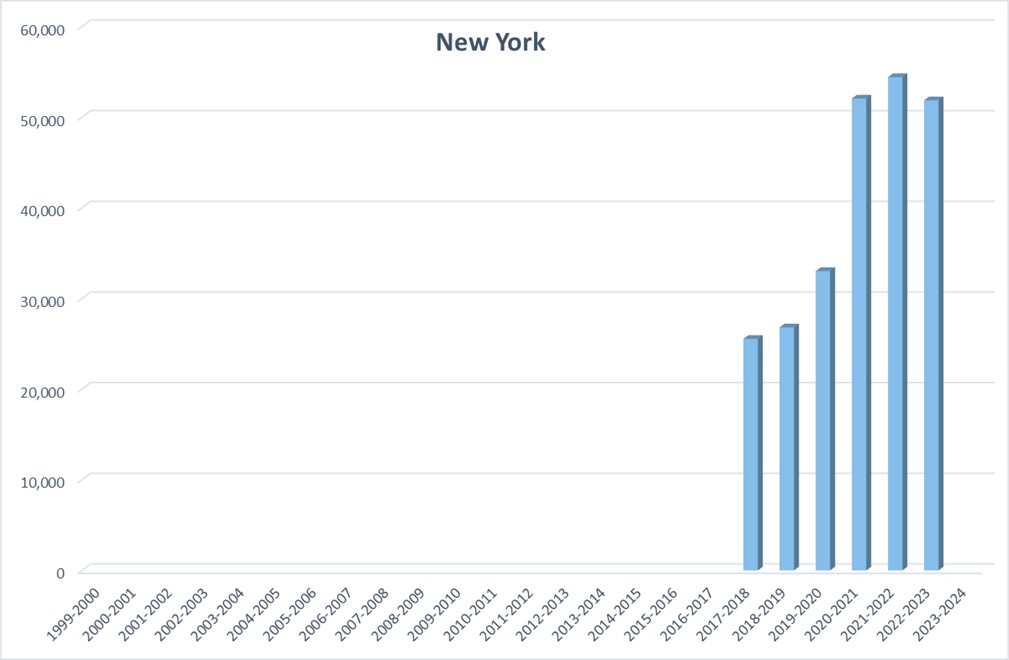New York collects but does not publicly report homeschool participation information. Access to public school offerings, including special needs services, is restricted.
History
New York is in the northeastern United States. Homeschooling has been legal in New York since 1987.
Regulation
New York offers one option for home instruction. Those interested in homeschooling children between the ages of 6 and 16 in the state of New York must provide a written notice of intent form to the local superintendent by July before the academic year begins. The school or district then sends homeschool regulations and a home instruction plan form to complete and return. Parents must identify the curricular materials they plan to use in the required subject areas. There are no education requirements for parents who wish to educate their children at home. Additionally, New York allows for a hired tutor to conduct the instruction. Required subjects vary by age/grade band and are quite detailed. Homeschooled students must test or be evaluated annually, and parents must keep and provide attendance records on demands from the district. Further, parents must provide quarterly reports. Students are required to meet daily and hourly instruction requirements.
There is no state policy for homeschooled student access to public school classes or activities. In fact, it appears that no nonpublic students of any kind have access to public school offerings, like courses and extracurricular activities, in New York. Some limited access to school-sponsored clubs may be available (CR135.1), but these students must provide proof of vaccination prior to participation. Homeschooled students cannot access special needs services (N.Y. Edn. Law §3602-c).
State Data
New York requires that all parents file homeschool participation information with the local school district, annually. However, the state does not report homeschool participation data. Researchers with The Washington Post recently collected participation data by district. According to those data, over 50,000 students were homeschooled in 2021-22.

While the lack of official data is problematic when students are required to file attendance, U.S. Census estimates indicate that around 1.2% of New York families homeschooled in the spring of 2020. Homeschooling increased to 10.1% by the fall of 2020. This falls just below the national average of 11.1% at the time. Based on U.S. Census data, our calculations indicate that about 3.23% of K-12 students in New York were homeschooled during the 2022-23 school year, and 3.66% during the 2023-24 school year. Due to survey changes, the data from 2020 reflects the percentage of households, while the data from following years reflects the percentage of students.
Cross-Sector Comparison
During the 2019-20 academic year, 1.1% of New York’s K-12 students were homeschooled. Homeschool participation in the state was much lower than the 11.5% of private school students. Charter school participation was also lower than private school participation in the state, at 5.2%. In 2021-22, 1.8% of New York’s K-12 students were homeschooled, and 12.0% attended private schools. Charter school participation increased slightly to 5.9%.


School Choice Context
In addition to homeschooling, there are several school choice options in New York. These include inter- and intra-district enrollment in traditional public, private, magnet, and charter. New York does not provide public funds for any nonpublic choice option.
Commentary
The rules governing homeschooling in New York are restrictive when compared to other states. Parents who wish to homeschool must go through multiple steps. Each step of the process requires approval and re-approval in a manner that seems bureaucratic when compared to other state policies. Further, parents must report their homeschool participation quarterly, yet the state does not publicly report any of this participation information. If families must report this information several times a year, then the state should consider publicly reporting homeschool participation information. Reporting the information they collect would increase transparency and understanding of homeschool participation in New York and the United States.

-
10.1% Families
Around 10.1% of families in New York homeschooled during the height of the pandemic (Fall 2020).
-
1987 Legalized
Homeschooling was legalized in 1987 in the state of New York.
-

-
More Information
10.1% Families
Around 10.1% of families in New York homeschooled during the height of the pandemic (Fall 2020).
1987 Legalized
Homeschooling was legalized in 1987 in the state of New York.

More Information
Last updated March 2025.